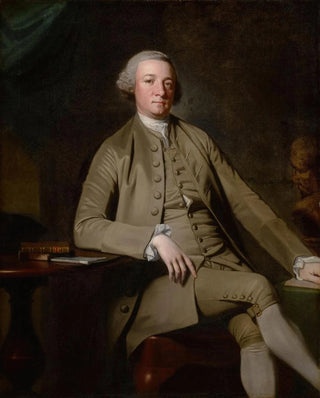Art print | Portrait of a gentleman sitting, probably William Suddel de Lancaster - George Romney


View from behind

Frame (optional)
In the vast panorama of art history, certain works stand out for their ability to capture not only the appearance of an individual but also the very essence of their being. The "Art print of a gentleman sitting, probably William Suddel de Lancaster" by George Romney is one of these masterful creations. Delving into this painting, the viewer is immediately transported to a bygone era, where elegance and refinement intertwine in every brushstroke. This portrait, both intimate and solemn, invites deep contemplation, revealing the subtleties of a personality through the visual language of art.
Style and uniqueness of the work
Romney, master of the portrait, excels in depicting human figures, and this painting is a perfect illustration. His style is characterized by striking realism and meticulous attention to detail. The textures of the clothing, the nuances of the skin, and the expression on the face are rendered with such precision that they seem almost tangible. The gentleman, sitting with a relaxed posture, exudes an aura of dignity and confidence. The color palette chosen by the artist, oscillating between warm tones and delicate shadows, creates an atmosphere that is both serene and emotionally charged. Every element of the painting, from the simple background to the carefully selected accessories, contributes to the overall harmony of the work, making this portrait a centerpiece of the 18th century.
The artist and his influence
George Romney, born in 1734, established himself as one of the most prominent portraitists of his time. Trained in oil painting, he developed a style that combines academic rigor with a unique artistic sensitivity. His work is marked by an exploration of themes of beauty, nobility, and the human condition. As an artist, he captured the spirit of his era, influencing many contemporaries and leaving an indelible mark on English painting. His innovative approach to portraiture, which emphasizes individuality and personal expression, paved the way for generations of artists.

Matte finish

View from behind

Frame (optional)
In the vast panorama of art history, certain works stand out for their ability to capture not only the appearance of an individual but also the very essence of their being. The "Art print of a gentleman sitting, probably William Suddel de Lancaster" by George Romney is one of these masterful creations. Delving into this painting, the viewer is immediately transported to a bygone era, where elegance and refinement intertwine in every brushstroke. This portrait, both intimate and solemn, invites deep contemplation, revealing the subtleties of a personality through the visual language of art.
Style and uniqueness of the work
Romney, master of the portrait, excels in depicting human figures, and this painting is a perfect illustration. His style is characterized by striking realism and meticulous attention to detail. The textures of the clothing, the nuances of the skin, and the expression on the face are rendered with such precision that they seem almost tangible. The gentleman, sitting with a relaxed posture, exudes an aura of dignity and confidence. The color palette chosen by the artist, oscillating between warm tones and delicate shadows, creates an atmosphere that is both serene and emotionally charged. Every element of the painting, from the simple background to the carefully selected accessories, contributes to the overall harmony of the work, making this portrait a centerpiece of the 18th century.
The artist and his influence
George Romney, born in 1734, established himself as one of the most prominent portraitists of his time. Trained in oil painting, he developed a style that combines academic rigor with a unique artistic sensitivity. His work is marked by an exploration of themes of beauty, nobility, and the human condition. As an artist, he captured the spirit of his era, influencing many contemporaries and leaving an indelible mark on English painting. His innovative approach to portraiture, which emphasizes individuality and personal expression, paved the way for generations of artists.






